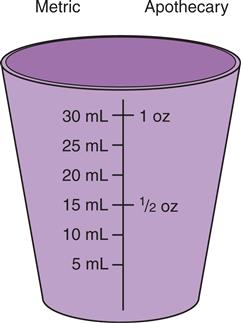 Equivalents between Apothecary and Metric Measurements
Equivalents between Apothecary and Metric Measurements
LEARNING OBJECTIVES
On completion of the materials provided in this chapter, you will be able to perform computations accurately by mastering the following mathematical concepts:
1 Recalling equivalent apothecary and metric measures
2 Computing equivalents between the apothecary and metric systems by using a proportion
3 Converting from the Fahrenheit scale to the Celsius scale
One of a nurse’s many responsibilities is the administration of medication. Historically, two different systems of measurements were used in the calculation of drug dosages: the apothecary system and the metric system. Currently, all hospitals and physicians use the metric system. Nurses should know the approximate equivalents between the two systems. This brief chapter is devoted to the parts of the apothecary and metric systems that are encountered most often.
 APPROXIMATE EQUIVALENTS BETWEEN APOTHECARY AND METRIC MEASUREMENTS
APPROXIMATE EQUIVALENTS BETWEEN APOTHECARY AND METRIC MEASUREMENTS
A list of the most commonly used equivalents between apothecary and metric systems of measure is provided in Box 8-1. Memorize these equivalents. Sometimes a nurse will have to convert from one system to the other. This can be done by using a proportion, as shown in the examples on pp. 134–135.

Example 1: 150 mL equals how many fluid ounces?
a. On the left side of the proportion, place what you know to be an equivalent between milliliters and fluid ounces. In this example the most appropriate equivalent is 30 mL = 1 fl oz. So the left side of the proportion would be
30 mL : 1 fl oz ::
b. The right side of the proportion is determined by the problem and by the abbreviations used on the left side. Only two different abbreviations may be used in a single proportion. The abbreviations must be in the same position on the right as they are on the left.
30 mL : 1 fl oz :: _______ mL : _______ fl oz
From the problem we know we have 150 mL.
30 mL : 1 fl oz :: 150 mL : _______ fl oz
We need to find the number of fluid ounces in 150 mL, so we use the symbol x to represent the unknown. Therefore the full proportion would be
30 mL : 1 fl oz :: 150 mL : x fl oz
c. Rewrite the proportion without using the abbreviations.
30 : 1 :: 150 : x

Stay updated, free articles. Join our Telegram channel

Full access? Get Clinical Tree



